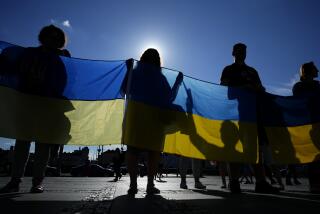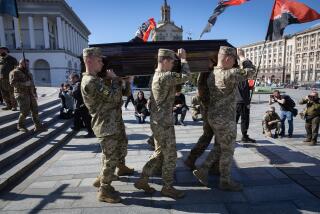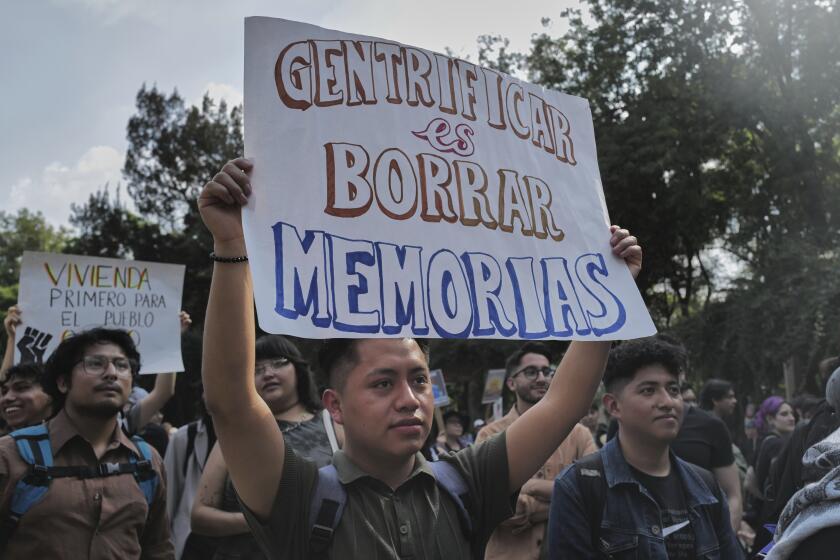Second Time Around May Be Worse
- Share via
STANFORD — The war in Chechnya is growing increasingly savage. Russian generals have moved their forces close to the capital of Grozny and have begun firing rocket salvos at the city. The fighting has been harsh, with Russian bombers and artillery repeatedly hitting both “strategic” and civilian targets. The Chechens, in classic guerrilla style, have effectively used hit-and-run tactics. This new war, which may already have taken 1,000 lives, could end up being as destructive as the 1994-96 conflict.
Perhaps the most worrisome aspect of the new conflict has been the emergence of a humanitarian catastrophe rivaling that experienced by Kosovar Albanians and East Timorese. Currently, an estimated 150,000 refugees, fleeing the bombing of civilian targets in Chechnya, are trapped in Ingushetia (population: 300,000), a largely Muslim autonomous republic sharing a border with the embattled region.
According to the Russian Ministry for Emergency Situations, 40% of the refugees are women, 45% children. Chechen men, for the most part, have not crossed the border, wary of Russian “filtration” points and their Gulag-like procedures. Some of the refugees have found temporary shelter in private homes, railroad stations and other buildings, but, according to Johanna B. Nichols, a professor of Slavic languages at UC Berkeley, more than 100,000 are living in the open air without adequate food, water, shelter, medical attention or sanitary facilities. The rainy season begins soon, with hard frosts to follow.
Despite protestations to the contrary, Russian authorities are not providing adequate care for these stranded people. International relief organizations are denied access to the refugees. On Oct. 12, the U.N. High Commission for Refugees announced that it was temporarily suspending aid shipments to Ingushetia because local authorities had failed to deliver supplies to those needing them most.
The Russian government’s intentions toward these stranded and desperate people remain unclear. It has driven them from their homes into Ingushetia in a campaign of terror bombing. There is growing evidence that the Russian government is seriously considering deporting large numbers of them to distant parts of the Russian Republic, including Siberia. The newspaper Segodnya reported that the Russian Federal Migration Service has prepared a list of regions to which the refugees would be “invited” to come. The Ministry for Emergency Situations apparently developed a similar plan for the deportation of Chechens in late 1994.
What should the West do about this steadily worsening situation? First, Western governments must insist that international humanitarian organizations--the U.N. High Commission on Refugees, the International Red Cross and the Nobel Prize-winning Doctors Without Borders--be given immediate access to refugees in Ingushetia. If the government of Boris N. Yeltsin continues to practice Slobodan Milosevic-style ethnic cleansing, all International Monetary Fund, World Bank and other loans must be reassessed. Confronted with a firm Western response, the Yeltsin regime will likely resort to a “backup” plan and, at least temporarily, move refugees into militarily occupied Chechen territory north of the Terek River; while dangerous, this might offer Chechens a better chance of returning home.
Russian government spokesmen contend that Chechens brought these misfortunes upon themselves through terrorist bombings in Moscow and Volgodonsk and through armed incursions into Dagestan in August and September of this year. There are, however, serious grounds to doubt the official version of these events. Two leading Russian newspapers, Nezavisimaya Gazeta and Izvestia, recently reported that secret-police investigators have concluded that ethnic Chechens were not involved in the bombings in Moscow and Volgodonsk and that nine of the 10 leading suspects reside in Karachevo-Cherkessia, another troubled republic of the North Caucasus region. The Cherkess, and not the Chechens, may well have carried out the bombings. It will be recalled that, early on in the police investigation, it was reported that the explosives used in the terrorist bombings and transported to Moscow had been placed in bags labeled “Cherkess Sugar Plant.”
Similarly, the armed incursions into Dagestan appear to have been carried out largely by natives of Dagestan, supported by some Chechens, Central Asians and others. If this is the case, the sole valid complaint that Moscow has against Aslan Maskhadov’s Chechen government is that it has failed adequately to police its border with Dagestan. This is a serious complaint, but does it justify the terror bombing of civilians, a practice prohibited by international law?
If the West does not energetically attempt to settle this conflict, the hostilities will likely turn into a protracted and increasingly vicious guerrilla war. If things end up going very badly for the Russians, as they did, say, in early August 1996, the “superhawks” conducting this campaign might be tempted to resort to weapons of mass destruction, perhaps chemical weapons, rather than admit defeat. If Chechen separatists become convinced that they, as a people, again face deportation and genocide, they might contemplate striking Russian nuclear reactors and similar targets, a scenario now under serious discussion in the Russian government.
To head off these potential nightmares, the United States and its allies must insist that the assistance group of the Organization for Security and Cooperation in Europe (OSCE) be returned to Grozny, with its safety guaranteed by Maskhadov, as he is guaranteeing the safety of Western journalists currently in his republic. As happened in 1996, the assistance group could facilitate negotiations between Maskhadov, the legitimately elected president of Chechnya, and high-level representatives of the Russian government. There is little time to lose; negotiations should commence immediately. Russia must be persuaded to accept the speedy return of such a mission to Grozny.
What might a successful negotiated settlement look like?
* A cease-fire would go into effect on the model of the successful arrangement of August 1996.
* All Chechen refugees would be permitted to return to their places of permanent residence.
* Russia would recognize Chechnya’s political independence, since there is now no possibility that Chechens would vote in a referendum to remain part of Russia.
* Chechnya would join the Commonwealth of Independent States (CIS) and acquire a status similar to such predominantly Muslim states as Azerbaijan and Uzbekistan (acquiring such a status was a constant refrain among separatist Chechens before the 1994-96 war).
* Russia would keep Chechen territory north of the Terek River and now occupied by Russian forces. (This land was joined to Chechnya in 1957, and Chechens are not emotionally attached to it.)
* The European Union, with support from the United States, would agree to restore the devastated Chechen economy and infrastructure and to provide jobs for a populace with an extraordinarily high rate of unemployment. Such a step would be as much in the interests of the European Union as it is in the interests of Chechnya and Russia.
An impossible plan? Perhaps. But contemplate the alternatives.
More to Read
Sign up for Essential California
The most important California stories and recommendations in your inbox every morning.
You may occasionally receive promotional content from the Los Angeles Times.













